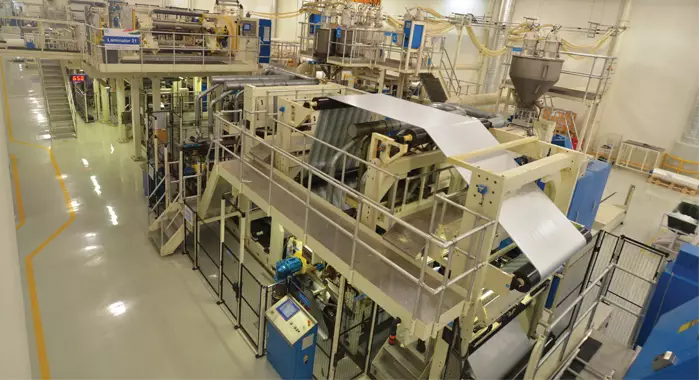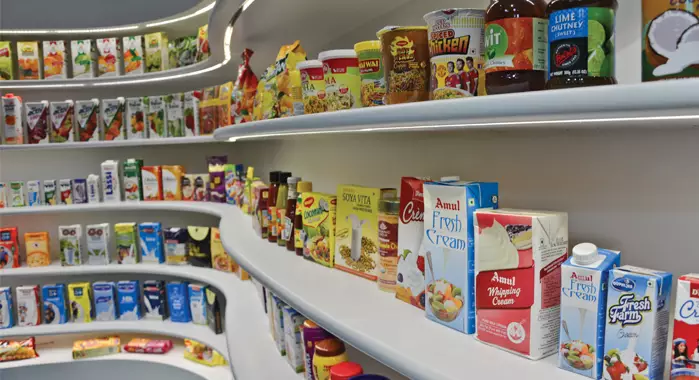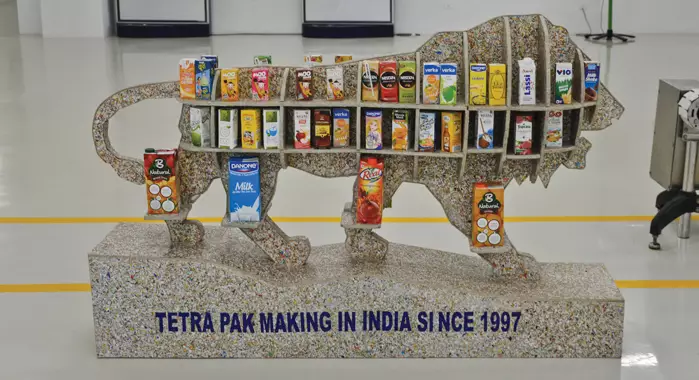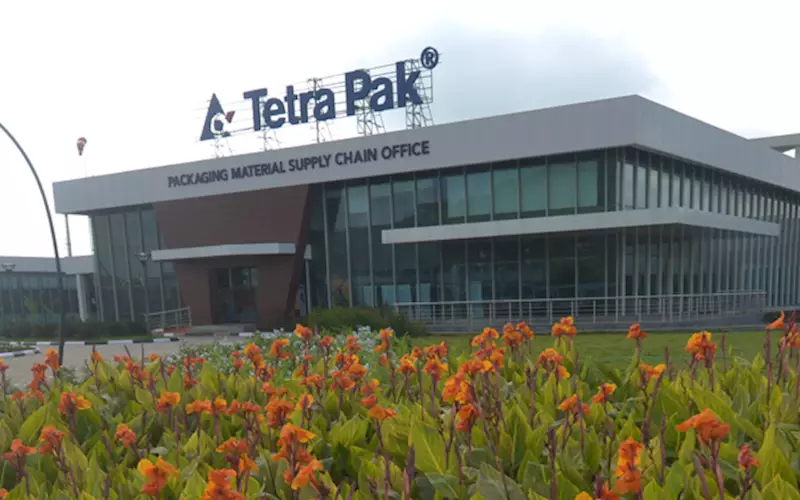A six-layer carton aspires to protect what’s good. What goes into making the packaging material is an eye-opener, says packaging technologist Priya Raju
The quantum of fresh produce lost in India is staggering. According to a Hindustan Times report, a government study shows that India is wasting up to 6.7 crore tonnes of food every year. The primary reason being inadequate refrigeration and supply chain infrastructure in India.
India is the largest producer and consumer of milk in the world; 130 million tonnes of milk are produced annually in India, yet a significant proportion of this is lost. This is because only a fraction of milk produced in India has access to cold storage.
While lack of cold storage remains an issue, what Tetra Pak’s technology has been able to achieve in terms of extended shelf life under ambient conditions without the need for chilled storage and distribution or the addition of preservatives is significant.
Last year, Tetra Pak sold around 800 crore packs in India. This year it will touch the 900 crore packs mark. In 2016 alone, the company sold 18,800 crore packs globally and had net sales of Euro 11.4 billion (approximately Rs 85,790 crore) from its processing, packaging and services business.
The factory
When PrintWeek India team visited 45-acre Tetra Pak factory in Pune, the sheer scale of operations was an eye-opener. From the moment we entered this facility, we could not help but be impressed by the attention to detail, from safety briefings to the state-of-the-art technology and even the green initiatives across campus.
The packaging major has come a long way since it established its first factory in India in 1997 in Takwe near Pune. The latest Chakan factory is one of Tetra Pak’s most advanced operations globally. It boasts of end-to-end solutions to integrate processing, packaging, automation and technical services. The Chakan factory was recognised as ‘Factory of the Year’ for 2015 among 42 Tetra Pak factories worldwide.
At the helm of affairs is Dilip Bhave, the factory director at Tetra Pak South Asia Markets. He talks about lean production with World Class Manufacturing (WCM) principles based on TPM (Total Productive Maintenance) concepts.
Bhave says, “Right from day one since the factory was established in 2012, we have strived to achieve operational excellence. To achieve the ‘Factory of the Year’ title, consistency in the past three years in terms of safety, quality productivity, cost efficiency and morale of the employees are judged. And we managed to bag the award at the end of three years.”
Bhave believes that there is still a long way to go. The factory has achieved the first three milestones – TPM excellence, TPM consistency and TPM special certifications – out of the five. The certifications are provided by Japan Institute of Plant Maintenance (JIPM), where in assessors from the Institute undertake a rigorous audit of the plant, before awarding the certification. Bhave assures that the factory is on track to achieve the World Class Manufacturing certification, the highest accolade, in the next few years. Bhave says, “This helps us to be competitive and to raise the bar every year.”
It is interesting to note that all the machines at the Tetra Pak factory are run at maximum speeds. Bhave contends, “The amount of time you waste when the machine is idle or running at a lower speed translates to losses.”
He adds, “We use the same tools of measurement since the beginning. But we have been consistent in deploying it and monitor the losses every quarter. So this is a continuous process improvement. This can be achieved only when you empower the employees, and at Tetra Pak each and every employee is involved in one or the other productivity improvement projects.”
A case in point for the operational excellence is the lean team size and the number of machines that the factory has maintained since its inception. The factory employs 200 people with 40 people in one shift. But the production output has almost doubled. Bhave says, “In the first year of operation our efficiency level was at 64%, today we have achieved 85% of efficiencies. With the same team size and equipment, the production output has reached 1200 crore packs this year as opposed to the first year in operation wherein around 600 crore packs were produced.”
The core values that drive Tetra Pak’s business has been based on customer focus and long term view, quality and innovation and responsibility. All this is reflected in the Pune factory.
New markets
In 2017 Tetra Pak completes 30 years in the Indian market. Tetra Pak’s growth story is reflected in its numbers. In last five to six years, the firm has trebled its sales, powering many a beverage’s growth in India. Gone are the days, where people in India preferred only the carbonated drinks. With growing demand for healthier drinks, India seems to be thirsty for drinks such as coconut water, nimbu paani and other ethnic flavours like those by Paper Boat, and Dabur, Yoodley among others. In addition, the other go to packaged drinks for India has been for flavoured milk and buttermilk.
In recent times, India’s packaged flavoured milk segment has seen a lot of action. Euromonitor research shows that retail volume sales for flavoured milk in India reached 20.6 crore litres and is expected to grow at 16% till 2019. Meanwhile flavoured milk volumes went from 11.6 crore litres in 2012 to 202 core litres in 2016. Many new, out-of-the-box introductions are adding new dimensions to the packaged liquid foods industry. One example is the new ready-to-drink malted drink Milo, by Nestle, which has been introduced recently to meet the consumer need for convenience and nutrition outside home for kids.
The inflection point in true sense for Tetra Pak was in 2011. This was the year when local innovations in terms of pack sizes and shapes, and indigenous brands entered the fray in beverages as well as new category creation.
All these trends plus Tetra Pak’s strategy has enabled the Swedish liquid foods processing and packaging company to grow manifold. In last few years the company has added the number of customers they cater to. In 2011, Tetra Pak had 60 customers and today, it has over 125. And according to Tetra Pak’s future strategy, it plans to add 100 more in the next few years.
Six layers of food safety
As the food distribution networks globalise, packaging plays a vital role in ensuring the final product is safe and secure for consumption. The main layer used for aseptic packaging is paperboard and the other material includes polyethylene and aluminium foil. These materials make the carton solid and help it being tamper evident. The biggest benefit of the aseptic packaging is that it gives the food a longer shelf life, as long as six to nine months, and eliminates the need for preservatives. In the most commonly used systems, the packaging material is produced and delivered to the food producer in large rolls, which are then formed into tubes and filled from pipes containing the liquid food product. The hygiene of the environment in which food packaging is manufactured is strictly controlled and also plays a part in the food safety process.
It is evident that innovation is one of the key elements at the heart of Tetra Pak India’s success. Starting with one TBA (Tetra Brik Aseptic) base pack and TCA (Tetra Classic Aseptic) at the beginning of India journey, today the portfolio is of over 20 different packs that serve different purposes, for different brands. The Chakan plant manufactures carton economy range – TFA (Tetra Fino Aseptic), TBA and TCA – that allows customers to offer products to the remotest parts of the country.
The integrated facility in Chakan supports the strong growth in the aseptic packaged food sector not only in the Indian market but also in other key geographies around the globe.
Processing applications and equipment manufacturing plant
The plant caters to the equipment and technology for processing products such as dairy, fruit juice, prepared food, cheese, ice creams, among other products and are deployed at customer plants across the country. For example, these types of equipment can be seen in major dairy manufacturers like Amul and ensure that the milk cartons are delivered across India with this technology.
The factory employs line manufacturing process, as seen in the automotive industry. After the final product is manufactured, the machines undergo a stringent quality check before the equipment is sent to the customer.
In addition, the Chakan plant also undertakes renovation of older machines supplied by Tetra Pak to offer cost effective solutions for companies looking to invest. The entire process for renovating a machine is 14 weeks. This amount of time is taken to make certain that each components of the machine undergoes a quality check and re-works if required.
This way the company ensures that the product sent (brand new or renovated) out of the Pune factory is of the highest quality.
Product development and innovation centre
Tetra Pak is not only about the six-layer carton packs; the Chakan plant is an end-to-end solutions provider for processing, packaging and service solutions needs. Apart from catering to the traditional brick-shaped packs and supplying the processing technology and equipment; Tetra Pak partners with existing brands and start-ups to share market insights and offers recipe formulation facility for what goes inside the pack too.
The PrintWeek India team got to sample some of the indigenously developed products at Tetra Pak’s product development and innovation centre. Some were focussed on specific health needs, while some transported us back to New Delhi with their flavours. While we cannot share more details of the products for confidentiality reasons, one thing is for sure, these products when launched are sure to create ripples in the market.
This facility has a product formulation and recipe-testing laboratory and a pilot processing and packaging plant that enables Tetra Pak’s customers to extend its R&D capabilities and helps shorten the product development time.
Greener footprint
Tetra Pak’s brand promise is based on the tagline ‘Protect what’s good’ of which two important dimensions included – food safety and sustainability. Jaideep Gokhale, communications director, South Asia markets at Tetra Pak, says, “The brand’s promise reflects our commitment to deliver unparalleled food safety while minimising the impact on the environment. Safety and sustainability are indeed the two key challenges facing the industry today.”
The Chakan plant boasts of being the first plant to receive platinum green certification, and one such example is recycling 100% of the water used in the plants. Tetra Pak has a separate environment team which ensures that all the waste generated during the manufacturing process and waste generated after use in the market are collected and recycled.
Tetra Pak also extends its sustainability agenda to the recycling of used Tetra Pak cartons. One of the latest initiatives to encourage recycling of used cartons, Tetra Pak has recently launched the ‘Cartons Le Aao, Classroom Banao’ campaign. This initiative is part of its on-going flagship programme ‘Go Green with Tetra Pak’. The initiative pledges to recycle over eight-lakh cartons and donate 200 school desks for underprivileged schools in 2017. Till date, hundreds of such benches are already functional in many schools across Mumbai and Pune.
Gokhale says, “The Cartons Le Aao, Classroom Banao initiative is aimed at bringing a behavioural change in consumers towards adopting green practices by encouraging them to deposit used paper-based Tetra Pak cartons for recycling at various collection centres.”
“Tetra Pak cartons are fully recyclable. The paperboard (which is 75% of the carton) is recycled into paper products and the 25% remaining fraction consisting of the polyethylene and the aluminium can be recycled into panel boards, roof sheets and so on,” he informs.
Globally, sustainability is an important priority for Tetra Pak. In addition to recycling, an important area of focus has been FSC (Forest Stewardship Council) – reportedly the world’s most credible certification system for forest products. More and more brands in Tetra Pak cartons in India now bear the FSC label - signalling that they comply with FSC requirements relating to forest management and the traceability of the wood fibre in the paperboard.
Aseptic technology - which Tetra Pak pioneered over half a century ago - has proven to be a solution to reduce food losses the world over and in transport, in addition to keeping food safe. And that’s why it is so relevant for India where our food processing sector continues to face widespread and perennial wastage of food. This aseptic technology has enabled the penetration of safe foods into the remotest parts of the country.
“This pioneering, advanced aseptic technology that we brought into India 30 years ago is made for India and well-aligned with our company’s vision to make food safe and available, everywhere,” contends Gokhale.
We agree.


















 See All
See All